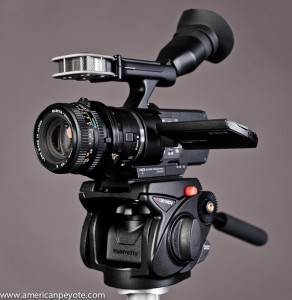 One large draw of buying into the Sony NEX system is the ability to adapt many different lenses to the camera bodies. I picked up a VG10 to shoot video, and to use all my medium format, Contax G, and Minolta lenses on a video camera. One of my favorite lenses to shoot with is the Mamiya M645 80mm f/2.8 N, and here are my initial experiences…
One large draw of buying into the Sony NEX system is the ability to adapt many different lenses to the camera bodies. I picked up a VG10 to shoot video, and to use all my medium format, Contax G, and Minolta lenses on a video camera. One of my favorite lenses to shoot with is the Mamiya M645 80mm f/2.8 N, and here are my initial experiences…
Mamiya Background
The 80mm is the standard lens for the Mamiya M645 medium format camera bodies. The Mamiya 645 system has been used extensively by pro shooters for decades, and the equipment was all built to pro standards, making it a quality purchase if found in good condition. The system started out as all manual, but has since evolved into autoexposure, autofocus, and digital with the introduction of the Mamiya 645AF and 645AFD. Since the introduction of the autofocus Mamiya cameras, the manual focus lenses have lost most of their value to digital shooters, and till recently, really only made sense to use on the older film bodies. However, a few manufacturers make adapters to mount Mamiya and Hasselblad lenses on DSLR bodies. For this reason I picked up a Cirrius adapter on eBay and some cheap used copies of the Mamiya 80mm and 150mm lenses to mount on my Sony A900. However, manual focusing sort of sucks on the A900, in particular if you shoot with old glasses like I do because you spend all your money on camera/video gear, computers, mountaineering trips, and retirement savings. If I had contacts it would be better, but at the moment I can’t accurately manual focus my A900. However, since all NEX cameras have live-view (like the A950 hopefully will have), the system makes an ideal candidate for use with my Hassy and Mamiya lenses.
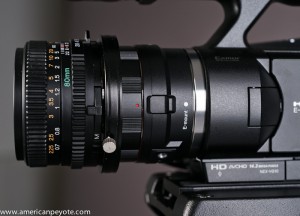 Mamiya Lenses on the VG10
Mamiya Lenses on the VG10
When used in conjunction with the LA-EA 1 adapter (Sony Alpha to NEX) I’m able to mount the Cirrius Mamiya to Alpha adapter onto my VG10 body, and thereby the Mamiya glass can be adapted to the NEX. The Mamiya lenses are nice candidates for the VG10 because they are compact and have smooth focusing action. When searching out a manual focus lens you want one with a dampened focusing ring. This means the focusing ring moves in a smooth motion, allowing to comfortable attain the correct focus. This is a big selling point of high-end glass like the Zeiss CP.2 compact primes. It should be easy to access the aperture dial as well. The focusing ring on the M645 80mm is prominent and easy to manipulate with the fingers, or for mounting a focus-follow device if desired (haven’t tried this yet on the VG10). The lens has a switch to allow full manual or automatic control modes on an M645 camera. If you put the lens in A-mode the aperture will stay open at f/2.8 no matter what. If you put it in M-mode you can then change the aperture as desired. On the VG10, you have to go into the menu system and turn on the option to allow the camera to shoot without lens attached (this only has to be once). You can now shoot in P or S mode. In P mode the VG10 can adjust ISO (if set to AutoISO) and shutter speed to attain the desired exposure. In S mode you can set the shutter speed and then allow the camera to set the exposure by automatically changing the ISO setting.
 80mm Performance
80mm Performance
The M645 80mm is a very nice lens, especially for the price you pay on the used market. The colors are great, it’s sharp, has nice bokeh, is compact, is easy to focus, everything you want in a manual focus lens. It could have more aperture stops, but that’s the only fault I see. On the VG10 it acts like a 120mm lens on a 35mm body but it only extends a couple inches from the body, much more compact than mounting my Minolta 85mm f/1.4 beast.
I’ve been shooting video and stills with the 80mm and am very happy with it so far. One video project at the moment is The Formers, a local band from Zurich that I’ve been working with. I took the VG10-80mm combo to their studio to shoot them in rehearsal (video coming soon). This entailed chilling in the room as they played with combined green and orange fluorescent lighting. I was manual focusing on the fly and shooting some stills here and there to sort of give the feeling of the ambiance of the place. I’ve also used the 80mm as a street lens, shooting grafitti, stickers, and flowers on the streets of Darmstadt. The main drawback so far is in the VG10, not the Mamiya.
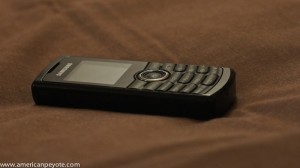 The main problem with manual focus lenses on the VG10 is focus confirmation. You can focus with the live-view feed off of the LCD screen, but you can’t zoom in like on other cameras to check critical focus before shooting. This makes it difficult to hit the focus point correctly, and really needs to be addressed in a firmware update. Ideally there should be a little area on the LCD which shows a 5-8x zoom of the scene so you can fine-tune your focus. One way to compensate for this is to use your knowledge of hyperfocal distances and shoot at f/5.6 or f/8, and you can then create properly focused images. The Cirrius adapter is also a weak component of the system. The adapter is ok, it mates the Mamiya mount to the Sony Alpha, but there’s some play in the rotation of the lens when mounted, and images are soft when focused to infinity.
The main problem with manual focus lenses on the VG10 is focus confirmation. You can focus with the live-view feed off of the LCD screen, but you can’t zoom in like on other cameras to check critical focus before shooting. This makes it difficult to hit the focus point correctly, and really needs to be addressed in a firmware update. Ideally there should be a little area on the LCD which shows a 5-8x zoom of the scene so you can fine-tune your focus. One way to compensate for this is to use your knowledge of hyperfocal distances and shoot at f/5.6 or f/8, and you can then create properly focused images. The Cirrius adapter is also a weak component of the system. The adapter is ok, it mates the Mamiya mount to the Sony Alpha, but there’s some play in the rotation of the lens when mounted, and images are soft when focused to infinity.
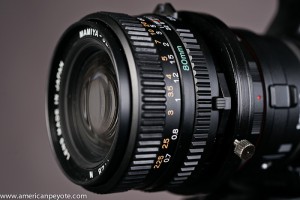 Summary
Summary
Overall the 80mm Mamiya 645 works very well on the VG10. The adapter from Cirrius isn’t really up to my standards, but it’s the only Mamiya to Alpha adapter I could find. Another option is to buy a Mamiya to Canon/Nikon and then a Canon/Nikon to NEX adapter, but that’s sort of expensive. I’m hoping that Fotodiox will release a Mamiya to NEX adapter in the future, as their Hasselblad to Alpha adapter is awesome and priced at a nice point. Better yet, if Fotodiox releases a tilt-shift Mamiya-NEX adapter I’d be super stoked. I’ve been lusting after a tilt-shift setup from Mirex to use my Mamiya lenses in that fashion, but that’s like almost 400 Euros. The tilt-shift thing would open up some interesting possibilities however, as I could then modify the focal plane as I want in relation to the people or things I’m shooting. Anyways, when you start lusting after more gear you know it’s time to use the stuff you have.
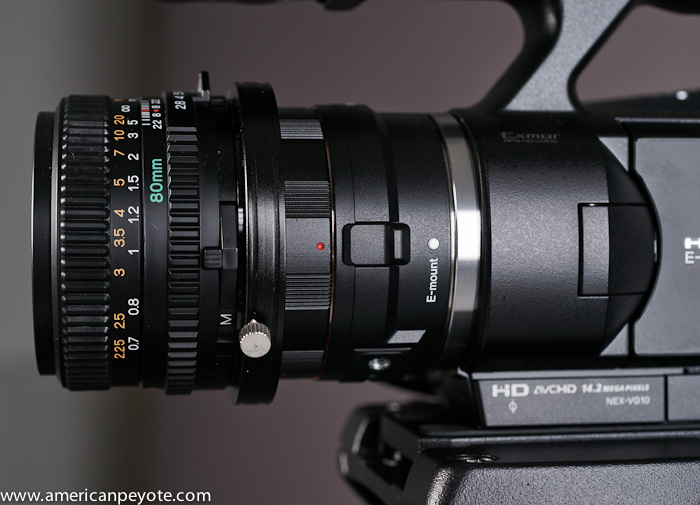
There is now a Mamiya 645 –> Sony E Cirrus adapter:
http://cgi.ebay.com/Mamiya-645-AF-M645-lens-adapt…
Excellent article. I got similar results with my ancient f 1.8 85mm Nikkor using the excellent Fotodiox adaptor to make the connect to the camera.